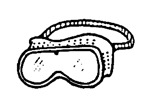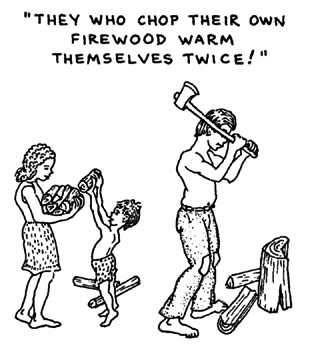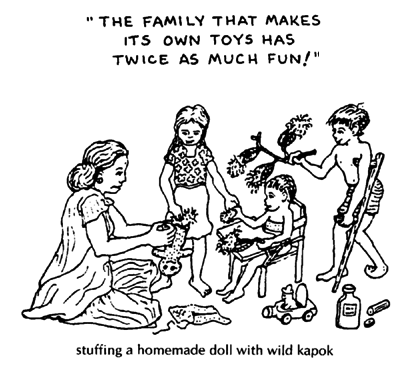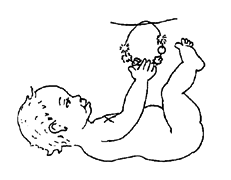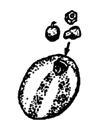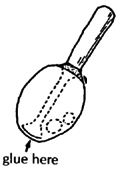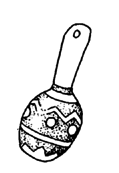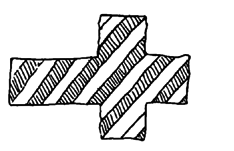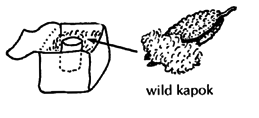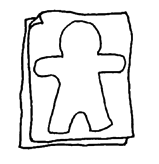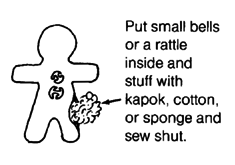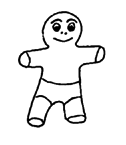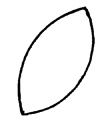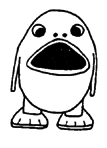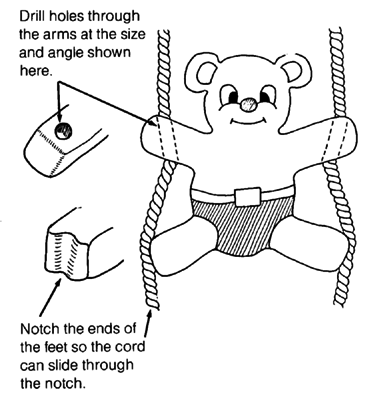CHAPTER 49
A Children's Workshop for Making Toys
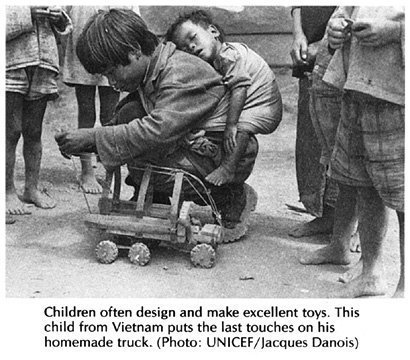
If a rehabilitation program is to achieve a strong base in the community, it needs to involve large numbers of local children. There are many important ways in which village children of various ages can take part, playing and working together with disabled children. We have already discussed how children can help build a low-cost 'playground-for all children'.
Another way that village children can contribute to a rehabilitation program is by helping to make special toys for disabled babies and children.
In Project PROJIMO in Mexico, village children help out in this way-and enjoy doing it. In addition to the toys that this voluntary 'labor' produces, it also brings together non-disabled and disabled children in a creative work-play relationship.

At first the children at PROJIMO made toys in the same workshop where the disabled staff was busy making braces, wheelchairs, and other orthopedic equipment. But soon things got too crowded. The children often played while they worked (which is natural), and a few important tools got broken or 'lost'. While there were advantages to letting the children work in the same shop with skilled disabled craftspersons, the team finally decided to create a separate 'children's workshop' equipped with its own basic tools.
In this workshop, children are invited to make educational and useful toys -'useful' in the sense that they help with a child's early development, providing stimulation, exercise, use of the senses, and learning of skills.
As the children or disabled workers become more skillful at making toys, some can be sold to help bring in money to the workers or program. Some of the toys and dolls made at PROJIMO are sold to visitors. In Jamaica, disabled young people run an economically successful factory, making wooden toys. Toys made at the Life Help Center for the Handicapped, Madras, India, are sold world-wide. (See booklet, Page 641.)
PROJIMO has an agreement with the children. The first toy they make is for the rehabilitation centeror for a particular disabled child. The second toy they make they can take home for a younger brother or sister. In this way PROJIMO and the school children also contribute to the development of non-disabled children in the village.
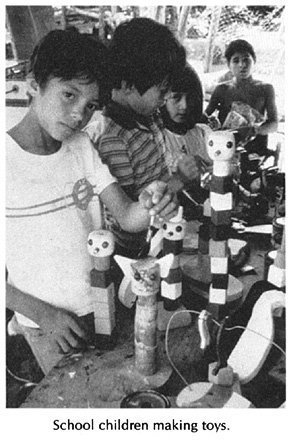
|
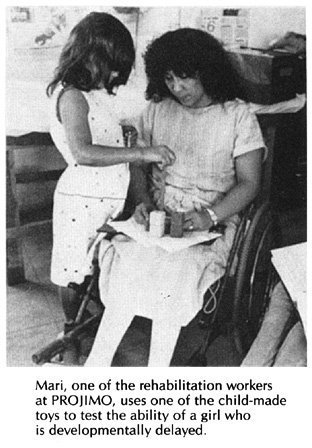
|
Another advantage to the children's workshop is that it provides experience, fun, productive activity, and skills training for visiting disabled children. Thus a child who needs to spend a few days in the village, while a brace or limb is being fitted or a joint is being straightened, can spend part of his free time in the workshop.
The orthopedic workshop is not strictly off-limits for the children. Occasionally a child who proves to be a responsible and serious worker will be allowed to help in the 'adult workshop'- perhaps helping to make crutches, braces, special seats, and other orthopedic equipment. But to gain working privilege in the 'big persons' shop, a child must usually first prove himself in the children's workshop. This helps reduce problems. But, of course, some problems do occur-as with any community action that is worthwhile.
Guiding and coordinating the children's workshop (we prefer 'guiding' to 'supervising') is an important job. It can be shared by different persons: rehabilitation workers, volunteer village craftspersons, or even some of the older, more responsible children as they gain experience. What is most important for such a coordinator is (a) that she like children,(b) that she be able to provide direction and keep order effectively without being bossy, and (c) that she be very patient.
Whether parents of visiting or local disabled children are invited as coordinators or helpers in the children's workshop can be decided depending on the particular parent and child. Some parents do a fine job. It may be an opportunity for a parent to relate to and work with his child in a completely new way. However, some parents may continue to overprotect and over-direct their own child or other children in the workshop. Many children need a chance to do and make things with other children independent of their parents' supervision or help. For such children, it may be best not to ask their parents to be present in the workshop.
Tools and equipment for a children's workshop
Here are some suggestions for basic equipment. You will want to consider what tools are commonly used and least expensive in your area, and equip the shop accordingly.
| Workbenches. You will probably need at least
2, at different heights. One should be just high enough for the
local size of children's wheelchairs to fit under. (Unfortunately,
many children are given adult-size wheelchairs with high armrests.
These often do not fit under a bench at a good height for
working.) Make workbenches strong enough so they do not move a
lot. |

|
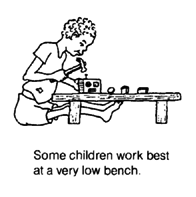
|
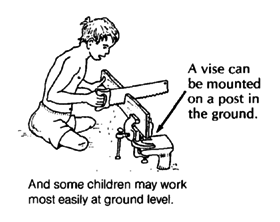
|
|
|
||||
|
|||||
|
|||||
|
|||||
|
|
||||
|
|
||||
|
|
||||
|
|
||||
|
|
||||
|
More expensive tools
If electricity is available and the program or community can afford it, a few power tools will make work faster, more fun, and more productive for the children. Clearly, care must be taken to avoid highly dangerous equipment. Make sure children take the necessary precautions. Here are some examples of electrical equipment that can make work much easier and faster:

| an electric jigsaw for making puzzles, wood animals, and so on |

| grinding wheel (hand or electric) |

| an electric drill with attachments for sanding and grinding |
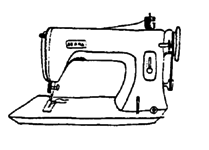
| A sewing machine (foot-powered or electric) will also be helpful in making many toys, dolls, and clothing. If the program can afford it, this machine can speed up sewing greatly, and help children learn an important skill. |
| CAUTION: Be sure children and
all workers use goggles (protective glasses) when using tools
where bits of wood or metal could injure eyes.
|
Gathering materials and supplies
Explore every opportunity to obtain low - or no-cost materials and supplies for making toys. Here are a few possibilities:
| Many materials for making toys can be gathered from local foress- branches of trees, reeds, bamboo, wild kapok (cotton). Also various nuts, seedpods, and seashells can be used. | |
| Broken fruit-packing boxes often have thin wood that is excellent for toy-making. Even the nails can be pulled out, straightened and re-used. | |
| Old tubes of car and bike tires provide elastic bands for many toys. | |
| Scraps of wood, wire, and other supplies left over by lumber stores, builders, etc. will often be donated if you explain why you want them. | |
| Clothing makers and factories may have scraps of cloth left over. | |
| Cardboard cartons, especially thick ones (even if broken) provide material for making many toys. Ask in local shops. | |
| Old cans, tins, plastic bottles, thread spools, and so on are also useful. |
Ask members of the community to look for and collect these and other supplies.
TOYS CHILDREN CAN MAKE
In a community rehabilitation program it is essential to have lots of toys-different playthings for children at different levels of development who have different strengths, weaknesses, and interests.
|
There is an old saying ...
|
|
We have a new saying ...
|
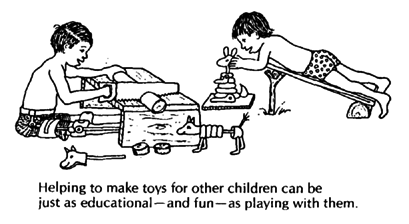
Many of the most fun, most educational toys can be made from scrap materials by members of the family or community. Disabled children with good hands can learn skills and take pride in making toys for other disabled children. So it makes sense to make toys rather than to buy them.

Spend money on TOOLS, not toys.
|
The following pages show a number of toys that children will enjoy making in a children's workshop. Or disabled children or their families can make them at home. We start with very simple toys for babies or children at an early developmental level. Gradually, the toys become more advanced. More skills will be needed by the children who make them, and by those who play with them.
| IMPORTANT: Please don't just copy the ideas for toys shown here. Be creative. And encourage the children making the toys to be creative. Help them use the examples shown on these pages as triggers to the imagination. Have fun! |
TOYS TO ENCOURAGE LOOKING AND LISTENING
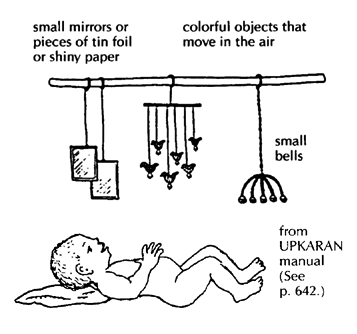
(See Page 642.)
TOYS THAT HELP DEVELOP USE OF HANDS AND SENSE OF TOUCH
You can make beads and chains out of wild fruits and nuts.
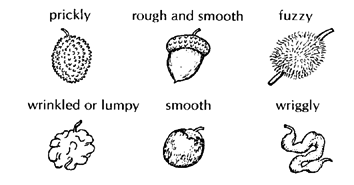
| CAUTION: Be sure not to use things that are poisonous, harmful, or that might get stuck in the child's throat, nose, or ears. |
| For a baby, hang a ring of beads' where she can reach and
handle it.
|

A child can play putting the nuts and pods in and out of a container. |
| Later he can learn to sort them -first by seeing them, and
then blindfolded.
|
As the child develops more hand control, she can begin to make chains and necklaces by stringing the nuts on a cord.
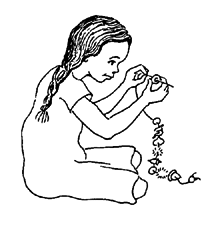
'Snakes' can be made by stringing nuts, 'caps' of acorns, bottle caps-or any combination of things.
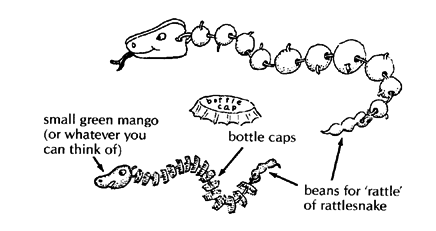
'Hedgehogs'

If you use your imagination, there are all kinds of toy animals you and your children can have fun making.
RATTLES AND OTHER 'NOISE TOYS'
Gourd rattle
| Find a small gourd (wild gourds or 'tree gourds' may
work.)
|
Cut a round hole at the stem and clean out the seeds and
flesh. Let it dry out well.
|
Put 2 or 3 small rocks, rubs or other objects inside.
|
| Find a stick the size of the hole. If the hole is large,
thin down this part of the stick.
|
Glue the stick to the gourd.
To make it stronger and better looking, mix white glue and sawdust, fill in here, and after glue dries, sand it smooth. |
Paint it colorfully.
|
Plastic bottle rattle

Bamboo rattle
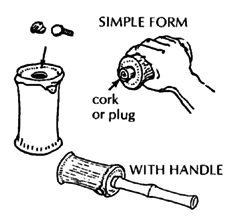
Tin can rattle
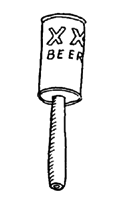
Cowhorn rattle
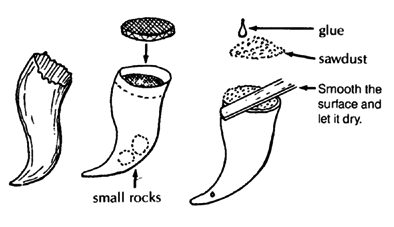

If the child drops or throws his toys, try attaching strings and help him learn to get them back by himself.
IDEAS FOR HOMEMADE 'MUSIC' (from How To Raise a Blind Child, see Page 639)
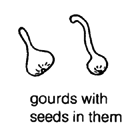
|
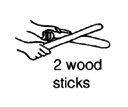
|
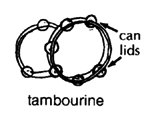 |
 |
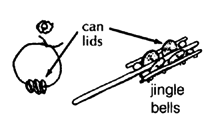
|
|
 |
||
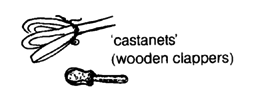
|
||
Soft rattle
| Use a small can or bottle with a small stone
inside,
|
or use 2 small bells.
|
Cut a colorful soft cloth (flannel) this is
shape.
Sew it into a square and turn inside out. |
| Place can or bells in cloth square and pack
wild kapok, cotton or bits of sponge around it. Sew it shut.
|
||
Doll rattle
| Draw a doll on 2 pieces of cloth, and cut them out.
|
Sew the 2 dolls together
|
| Turn the doll inside out.
|
Sew or draw on a face.
|
Animal rattles can be made in the same way

Ball rattle
| Cut 3 pieces of cloth of one color.
|
and 3 pieces of another color.
|
Sew them together except for a small hole. Turn inside out
and stuff.
|
Push-a-long noise toy
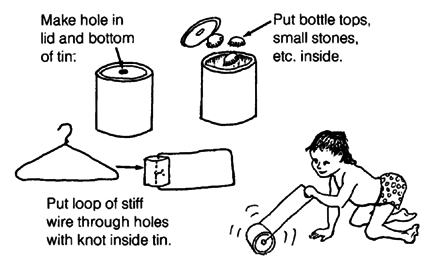
Bamboo push-a-long
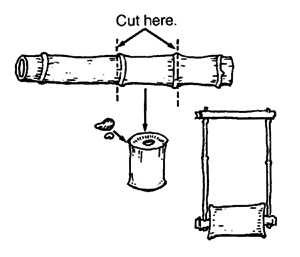
Plastic bottle pig
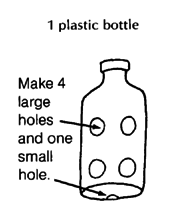
|

|
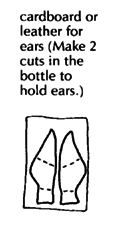
|
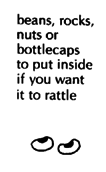
|
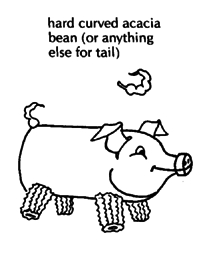
|
|
Papier-mâché piggybank
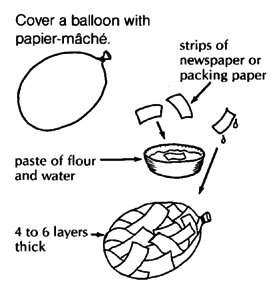
|

|
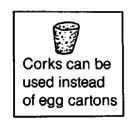
|
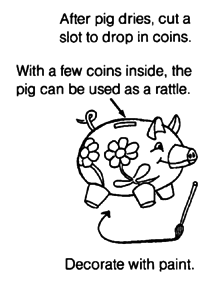
|
Children can improve hand control, learn to count, and learn about money by playing with coins and the piggybank.
Papier-mâché frog
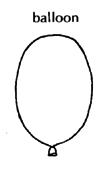 |
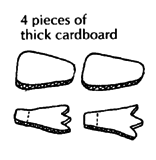
|
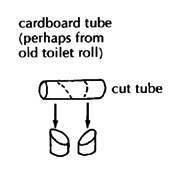
|
| Cover with papier-mâché and attach 'feet' and 'hands'.
|
When dry, cut out mouth and paint.
|
|
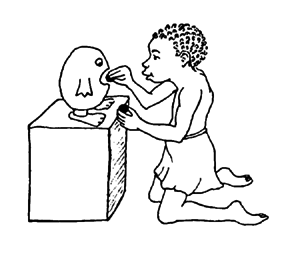
The frog can be used as a handy storage container or cookie jar.
Children who need to develop hand control can play 'feed the frog' - taking objects in and out.

Note : For the pig and frog, you can use a large gourd instead of a balloon. |
Games fitting pegs or blocks into holes help develop better hand control and 'hand-eye coordination'. They also help the child learn to compare sizes, shapes, and colors.
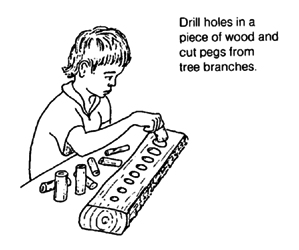
|

|

|
|

|

|

Other ideas

Blocks for building a tower on pegs
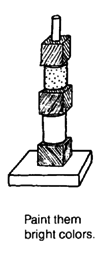

'Animal stackers'

Slide-on wire toys
To help develop fine control of hand movement, blocks, beads or animal figures can be moved along a wire. Children with poor control need only move the figure from one side to the other. Children with good control try to move the figure without touching the wire. The more bends you put in the wire, the harder it is.

Gourd racing car

Gourd baby
| The gourd baby is fun because it can be given drinks and then 'go to the latrine'. Thus it can be a good tool for 'toilet training' children. For other ideas and dolls for toilet training, see Page 341. |
 |

|
Shapes on pegs*
With these, children learn about matching colors, shapes, and sizes.

Figures with posts for easy gripping*
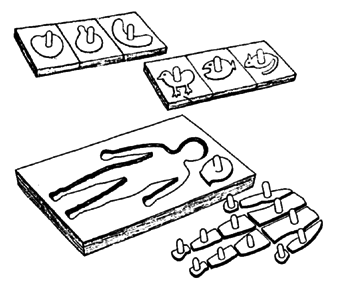
Building blocks*
(of wood, clay, or layers of cardboard)
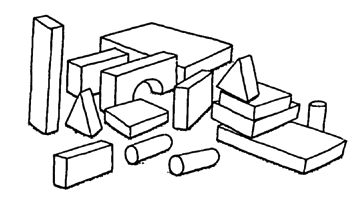
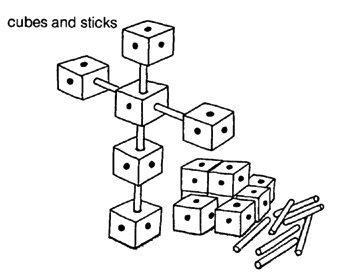
*These are from the UPKARAN Manual (See Page 642.)
Biting donkey
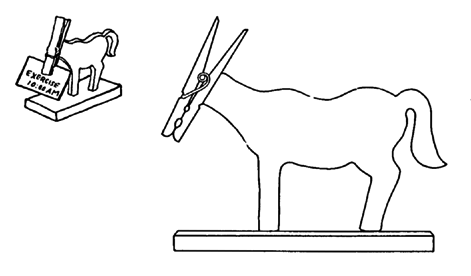
This wooden donkey or horse with a clothes-pin head is fun to make and to play with.
It can also be used as a note or reminder holder. Perhaps disabled children at the rehabilitation center can make this to sell for pocket money.
Trace the donkey onto a piece of wood about as thick as the clothes-pin (1 cm). Cut it out with a jig saw. Also make a base, as shown. Sand pieces smooth and glue together.
Donkey carts

Climbing bear
| Cut a pattern of the bear out of a wood board about 2 cm.
(3/4 inch) thick.
|
| Hang a stick from the roof or a tree limb.
By pulling one cord and then the other, the bear will climb the ropes! Children love it! Good for developing use of both hands together. |
RUBBER BAND WIND-UP TOYS
Steamroller

Paddle wheel boat

|

Use it to help the child enjoy bathing, develop hand control, and even speech. |
Corncob creeper
Use an old spool or corncob.
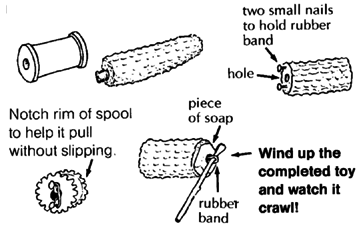
For more fun, place a paper cone over the creeper, and decorate it to look like a person or animal.
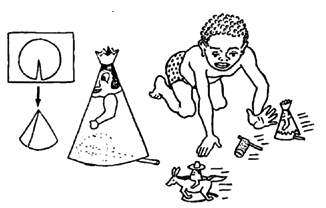
Whirlygig screech plane

This simple noise toy can be made completely of waste material. The pin mounted at the front scrapes against the inside of the bottlecap-and the cups amplify the noise like the loud-speakers of a record player.
It whirls!
It squeals!
It flutters!
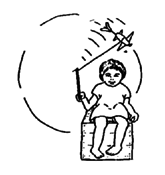
PUZZLES
Puzzles can help a child learn how shapes, forms, and colors fit together. Puzzles can be made by glueing a picture on cardboard, wood, plywood, or other material. Cut out the pieces with a coping saw. Puzzles can be made in various styles:
Flower puzzles
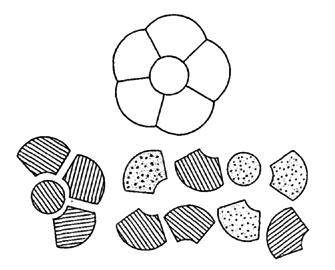
Children can first learn to form one flower.
Later, they can play 'sorting games' with flowers of different colors.
Figure puzzles
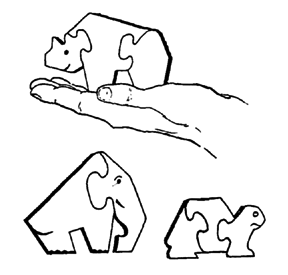
Several children can play to see who can complete a flower first-using dice with different colored sides.

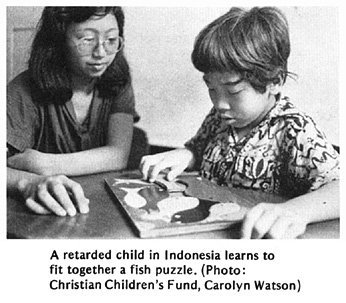
Puzzles with cut-out pieces that follow the forms and lines of the drawing
First have the child build the main object (here, the owl) with a few pieces. Later, she can learn to fill in the background.
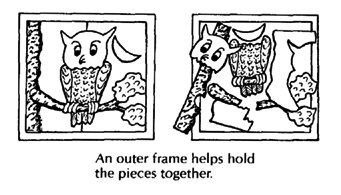
Puzzles with interlocking pieces
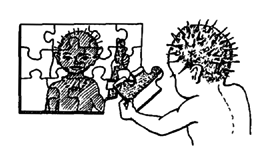
Suggestion: If you have a large photo of the child or a family member, glue it on cardboard and cut out the puzzle. Or use a picture from a magazine or calendar.
Block puzzles

Glue 6 different pictures to the sides of a thick board or sheet of foam plastic, and cut it into blocks. You can also make blocks from cubes of clay or small match boxes.
Ideas for the toys shown in this chapter are from many sources, including books. For books on toys and games, see Page 641. Other toys are on pages 253, 317, 318, 341, 347, and 392.















